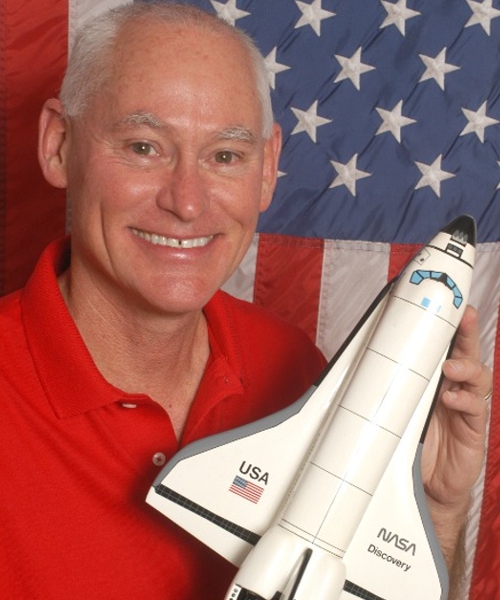
Mike Mullane
KEYNOTE SPEAKER
Keynote Safety Speaker, Former NASA Space Shuttle Astronaut
Former Astronaut, Author Colonel Mullane served as a Mission Specialist in the first group of Space Shuttle Astronauts. His key focus is on TEAMWORK and its profound impact on safety. His inspirational, motivational, and humorous descriptions of the Astronaut experience and how teamwork impacts safety, hits home.
Biography
Colonel Mullane has established himself as an acclaimed professional speaker on the topics of teamwork, leadership and safety. He has educated, entertained, inspired and thrilled tens of thousands of people from every walk of business and government with his incredibly unique programs.
From combat reconnaissance missions over the skies of Vietnam, to Space Shuttle missions, to climbing some of the highest peaks across the globe, Mike Mullane knows what teamwork, leadership and safety are all about.
His programs on these topics have educated, inspired and motivated tens of thousands of people from every walk of business and government. In addition, Astronaut Mullane has authored several critically acclaimed books and videos. Welcome to this portal into Mike Mullane’s life and work.
Featured Keynote Programs
Countdown To Teamwork/Leadership/Safety
The actual program title will be selected during a pre-event teleconference with the Client to ensure it fits the objectives of the meeting. In the same teleconference Astronaut Mullane will coordinate with the Client, using the following outline, to tailor his comments to the meeting objectives.
Please note that Mullane’s programs are lavishly supported with rarely seen NASA videos and photos making it very easy for any audience (including non-technical audiences) to follow and understand the message. You do not need to be a rocket scientist to be thoroughly educated, inspired and motivated by Mullane’s presentations!
Normalization of Deviance
Mullane will use the Space Shuttle Challenger disaster as an example of how a World-Class team can be victimized by incremental deviances from teamwork, leadership and safety best practices.
Challenger was a result of a catastrophic failure of the O-rings, Criticality 1 components used to form pressure seals between the four propellant-filled segments that comprise the twin solid fueled rocket boosters. Even though there were multiple instances of leaking O-rings in the 24 missions preceding Challenger, launches were never suspended to give engineers adequate time to address the problem. In hindsight, the serial justifications over a 4 year period to continue launch operations, reveal an incremental creep from best practices, i.e., a normalizing process. Challenger proved to be a ‘predictable surprise’. The following lessons will be extracted from the story of Challenger:
- Normalization of deviance is rooted in decision-making while under job-related or personal pressures. Everybody is vulnerable. Procedural compliance will always be the best defense. Make it a religion.
- Maintain situational awareness. Have a questioning attitude.
- Risk has no memory. Risk is not diminished by the frequency at which one is successful in taking the risk.
- Beware of this thought process, ‘These are exceptional circumstances. I must take the short-cut. Next time I will do it right.’ One successful safety short cut provides this false feedback: The absence of a negative consequence suggests a risk previously believed to be absolute is, in fact, manageable. One short-cut opens to door to more.
- Set challenging but attainable goals. NASA’s shuttle launch goal of 24 missions per year proved to be unattainable and pressures that resulted from that goal were significant factors in the tragedy.
Responsibility & Accountability
Mullane will introduce this discussion with a personal story from his USAF flying career. At the time of the story, Mullane was a very experienced Weapons System Operator from the backseat of the reconnaissance version of the F-4 Phantom jet fighter but making his first flight in a swing-wing, supersonic F-111 jet. Ultimately, he and the pilot had to make a last second ejection from the crashing jet. This crash was due to crew error…including Mullane’s failure to speak up at a critical moment in the flight. From this story he will develop these lessons:
- See something, Say something. Do something.
- We’re all in it together. In hazardous operations, the actions/inactions of a single individual can endanger everybody. Take each other’s back.
- One person with courage forms a majority. You count. You are unique. You might see something safety-related that nobody else sees. Never be a ‘safety passenger’ and assume somebody else will ‘take care of it.’
- Leaders: Empower your teams so everybody does count.
- We all contribute to the safety culture of a team and will be accountable for our contribution. In hazardous operations, you may not get a ‘do-over’. OWN your safety responsibility.
Videos
Video Presentation: Countdown To Teamwork/Leadership/Safety – Snippet 05:57